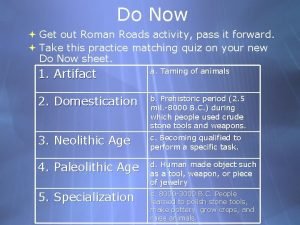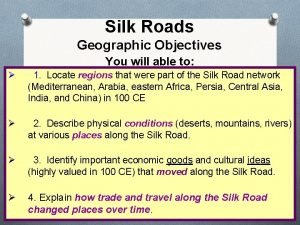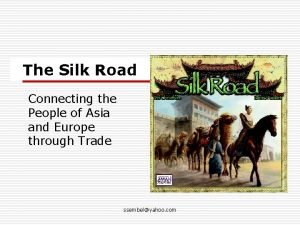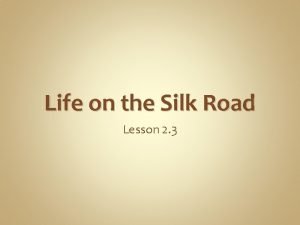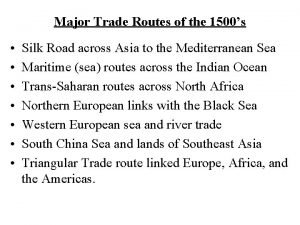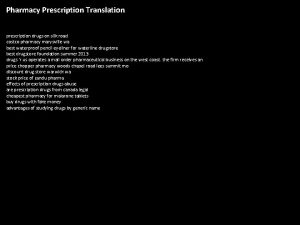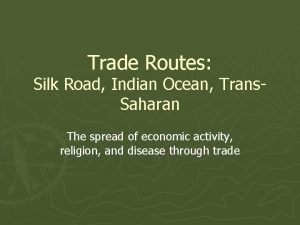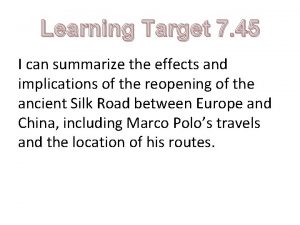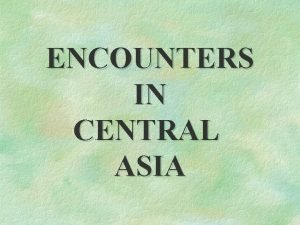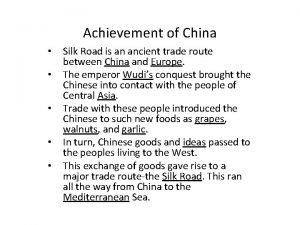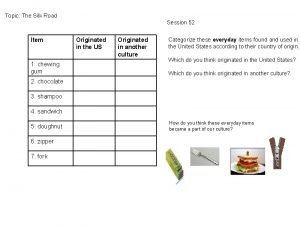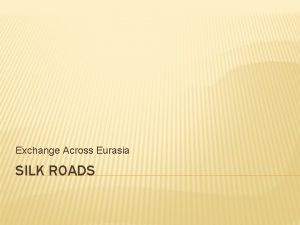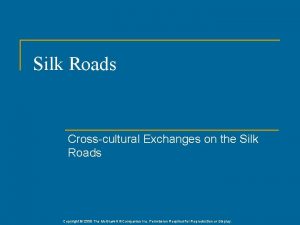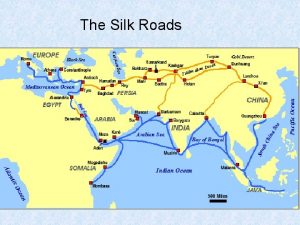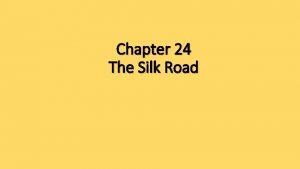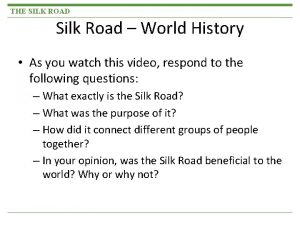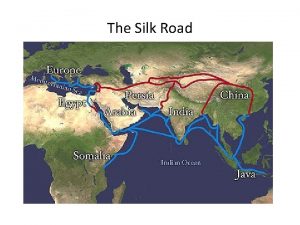The Silk Roads Or hey this road isnt













- Slides: 13

The Silk Roads Or, hey this road isn’t very smooth for being made of silk…?

Today’s Learning Objectives U 2, A: Explain the causes and effects of growth of networks of exchange after 1200 U 2, C: Explain how the expansion of empires influenced trade and communication over time U 2, J: Explain the intellectual and cultural effects of the various networks of exchange in Afro-Eurasia from 1200 to 1450 U 2, L: Explain the similarities and differences among the various networks of exchange in the period from 1200 to 1450

Ground Rules 1. The “Silk Road” refers to a massive number of separate trade routes, not all of which existed at the same time 2. Silk was not the only thing traded along these routes—not even close 3. None of the individual participants understood the scope of the Silk Road They saw a way to get nice things they didn’t have, they did not see a continent-spanning network 4. This is relay trade: goods changed hands multiple times before reaching their end destination

A larger view of the map

Geography and Trade v Eurasian geography: v Outer Eurasia is largely warm, wellwatered land (China, India, Mesopotamia, the Mediterranean) v Occupied for most of recorded history by settled, farming societies v Inner Eurasia is largely colder, harsher, and drier (Russia, Central Asia, Tibet) v Occupied by nomadic pastoralists v Settled societies were linked by pastoral nomads

Who Promotes Trade? v Trade is most often promoted by large, stable empires v Empires create the stability necessary for trade and the markets which demand trade v The Mongol Empire and its successor states made the Silk Road a safe trade route which linked enormous distances in Eurasia v The route served as a major highway for goods, culture, and disease

Another traveler’s journal ahead: Marco…

What Spread Along the Silk Roads? Oh look, another chart (Simpson says with total exasperation) On your blank sheet of paper, make a three-sectioned chart with the following categories; goods, culture, and disease

Goods! v Silk Road trade was expensive and frequently dangerous v As a result, the goods were expensive and readily moved v So good, people risked it fortune and glory v China held a monopoly on silk production until the 500 s CE v Post-China silk was just as lucrative

Why silk? Silk is a light, incredibly comfortable fabric which is extremely difficult to produce, but comfortable in most weather conditions Silk is time-consuming to make, has limited geographic production range, and is in highdemand virtually everywhere In short, it was the perfect trade good for Silk Road trade

More Goodies v Chinese peasants would occasionally abandon farming staples (rice) to produce silk, porcelain, or paper—hoping to get paiiid v Well-placed individuals (usually located between major civilizations) could become extremely wealthy

Culture! Trade linked many different cultural groups, and enabled the spread of multiple ideas v The most important cultural aspect that spread along the Silk Roads was Buddhism v Early Buddhism had appealed to Indian merchants – it rejected the Hindu caste concept! v When these traders became a key portion of the Silk Road trade, Buddhism came along with them—usually the more accessible Mahayana form, which did not emphasize the priestly lifestyle v

Disease! v Trade spreads diseases— especially to populations with no existing contact or immunity v The following diseases spread along trade routes during this period (or the previous unit: ) v Smallpox v Measles v Black Plague (multiple times from Asia to Europe: Byzantine Empire in the 500 s, Europe in the 1300 s)
 Song with hey in chorus
Song with hey in chorus Modern roads vs roman roads venn diagram
Modern roads vs roman roads venn diagram Dunhuang
Dunhuang Silk road mind map
Silk road mind map Silk road map activity
Silk road map activity Trans saharan trade route
Trans saharan trade route 1500 trade routes
1500 trade routes Costco pharmacy marysville
Costco pharmacy marysville Trans saharan trade route map
Trans saharan trade route map Silk road goods traded
Silk road goods traded Silk road multiple choice questions
Silk road multiple choice questions Silk road map route
Silk road map route Silk road achievements
Silk road achievements Silk road trade route
Silk road trade route

